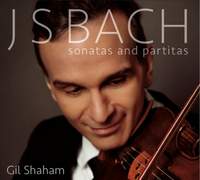Recording of the Week,
Violin music by Bach and Vivaldi from Gil Shaham and Rachel Podger
A double-bill of violin showpieces this week – Messrs Vivaldi and Bach present two very different calling-cards with the former's L'estro armonico (twelve concerti for between one and four violinists, with strings and continuo) and the latter's three sonatas and partitas for unaccompanied violin.

Vivaldi's hugely influential collection of concertos represents perhaps the pinnacle of his quintessentially Italianate genius. They made such an impact on the musical world of Vivaldi's time that even the great JS Bach transcribed six of them for alternative forces. The title of the collection is a little bewildering to translate, but 'a musical rapture' comes close, and it's a good indication of the spirit of the works, as the soloists (between one and four violinists) seem to lose themselves in sheer virtuosic invention. This is all the more effective when it is imitative between the parts, as in the opening of the first quadruple concerto in D major.
Rachel Podger suggests in her accompanying notes the image of the soloists duelling, attempting to outdo each other with entries she likens to rapier-thrusts. The nature of the opposing forces vary – sometimes Rachel alone is pitted against the orchestra, for example, or sometimes a Corelli-like model is followed with a concertante trio of two violins and a cello – but the interplay between them is consistently lively. The music is delightfully spiced with occasional uses of a guitar in the continuo, for a little extra Mediterranean flavour!
The spirit of the Four Seasons, written about a decade later in 1720 or so, is already very audibly present - the start of the concerto in G minor (RV578) clearly has a lot in common with the chilly spiccato of Winter, for example - and although there's no overtly visual programme or theme as in the case of the Seasons and other concertos, the musical language is just as vivid. Podger and her Brecon Baroque players make it sound like the easiest thing in the world, dashing off ornaments and runs without a backward glance, and the ensemble (led by Podger from the violin) play as if they were one musician.

I mentioned Bach's fascination with these concertos a few paragraphs back; in fact at the very same time as Vivaldi's sunny Italianate writing was wowing audiences all over Europe, Bach was at work on his own virtuoso love-letter to the violin – his sonatas and partitas for solo violin were, like Vivaldi's Four Seasons, completed about ten years after L'estro armonico. Gil Shaham has recently committed all six works to disc, and as so often when a new recording of a well-established benchmark piece comes out, it's fascinating to see how the performer has made it their own in a new way. Shaham has evidently built up his own interpretation of these pieces from scratch – informed by recent research into the social context of the dances which form the basis of the partitas, and taking full advantage of period performance practices and equipment, in particular the use of a Baroque bow, which makes some of the faster passages audibly more nimble.
Indeed his tempi are surprising in some cases – often on the fast side of what I'm used to, as in the Fugue of the G minor sonata, in which Shaham rejects the spacious, dramatic style in which it's often played in favour of keeping the music flowing along. For me at least, the faster speed actually makes the fugue work better – I found my ears could better keep track of the various parts and I heard it as a fugue in a way I hadn't really before.
Without wishing to put forward a definite theory in the absence of serious supporting evidence, it's not hard to imagine Bach absorbing the violin writing of Vivaldi as he was composing the sonatas and partitas around the same time. Shaham's light, athletic playing does much to close the gap between the North and the South European composers, and above all he never loses sight of the fact that this is, fundamentally, dance-inspired music - particularly so in the case of the partitas. It's all too easy to adopt a reverent playing style when tackling cornerstones of Bach's output, and the sense of fun can sometimes be a casualty of this. Shaham's great achievement in these works is to put the dance back into the music.
Rachel Podger (violin & director), Brecon Baroque (Released on 16 March 2015 - available to pre-order now!)
Available Formats: MP3, FLAC, Hi-Res FLAC, Hi-Res+ FLAC
Gil Shaham (violin)
Available Format: 2 CDs




